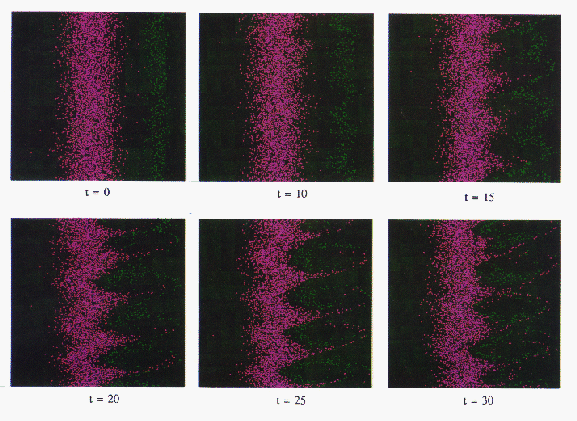




Next: Performance Results for
Up: Plasma Particle-in-Cell
Simulation
Previous: 9.3.2 GCPIC Algorithm
The problem used to benchmark the one-dimensional electrostatic GCPIC code on
the Mark IIIfp was a simulation of an instability in a plasma due to the
presence of an electron beam. The six color pictures in Figure 9.4
(Color Plate) show results from this simulation from the
Mark IIIfp. Plotted is electron phase space-position versus velocity of
the electrons-at six times during the simulation. The horizontal axis is
the velocity and the vertical axis is the position of the electrons.
Initially, the background plasma electrons (magenta dots) have a Gaussian
distribution of velocities about zero. The width of the distribution in
velocity is a measure of the temperature of the electrons. The beam
electrons (yellow dots) stream through the background plasma at five times
the thermal velocity. The beam density was 10% of the density of the
background electrons. Initially, these have a Gaussian distribution about
the beam velocity. Both beam and background electrons are distributed
uniformly in x. This initial configuration is unstable to an electrostatic
plasma wave which grows by tapping the free energy of the electron beam. At
early times, the unstable waves grow exponentially. The influence of this
electrostatic wave on the electron phase space is shown in the subsequent
plots. The beam electrons lose energy to the wave. The wave acts to try to
``thermalize'' the electron's velocity distribution in the way collisions
would act in a classical fluid. At some point, the amplitude of the wave's
electrostatic potential is enough to ``trap'' some of the beam and background
electrons, leading the visible swirls in the phase space plots. This
trapping causes the wave to stop growing. In the end, the beam and
background electrons are mixed and the final distribution is ``hotter''
kinetic energy from the electron beam which has gone into heating both the
background and beam electrons.

Figure 9.4: Time history of electron phase space in a
plasma PIC simulation of an electron beam plasma instability on the Mark
IIIfp hypercube. The horizontal axis is the electron velocity and the
vertical axis is the position. Initially, a small population of beam
electrons (green dots) stream through the background plasma electrons
(magenta dots). An electronic wave grows, tapping the energy in the
electron beam. The vortices in phase space at late times result from
electrons becoming trapped in the potential of the wave. See section 9.3 of
the text for further description.





Next: Performance Results for
Up: Plasma Particle-in-Cell
Simulation
Previous: 9.3.2 GCPIC Algorithm
Guy Robinson
Wed Mar 1 10:19:35 EST 1995





